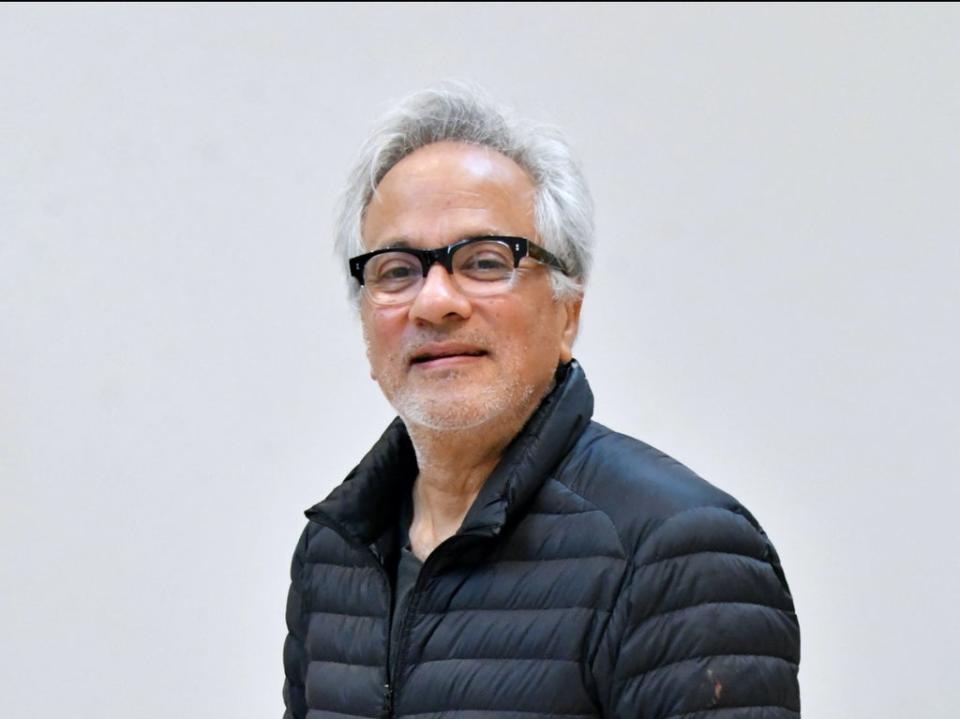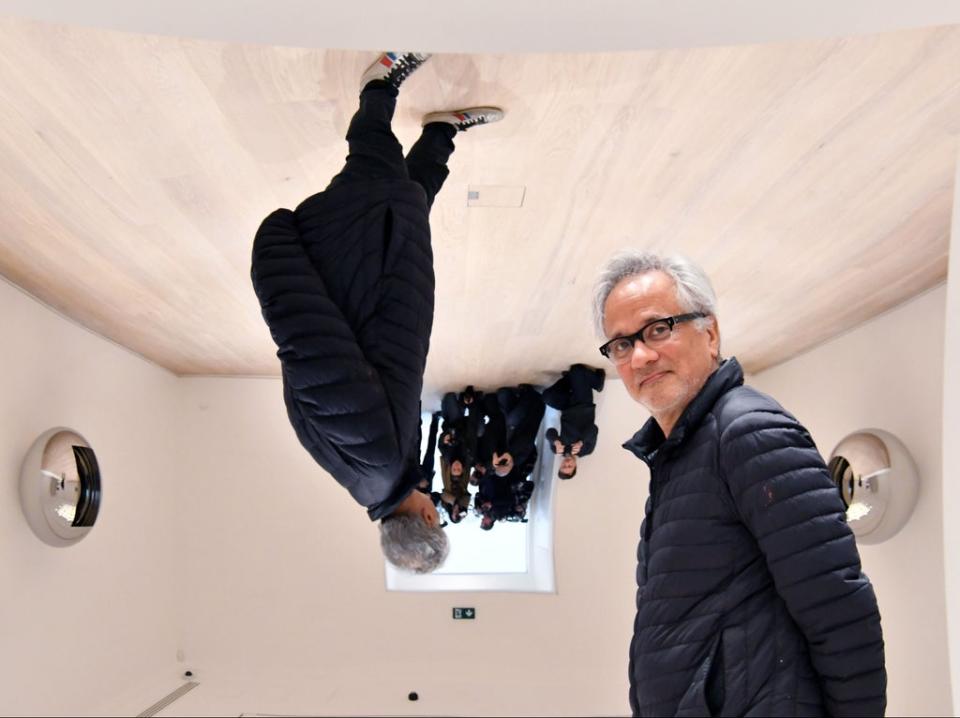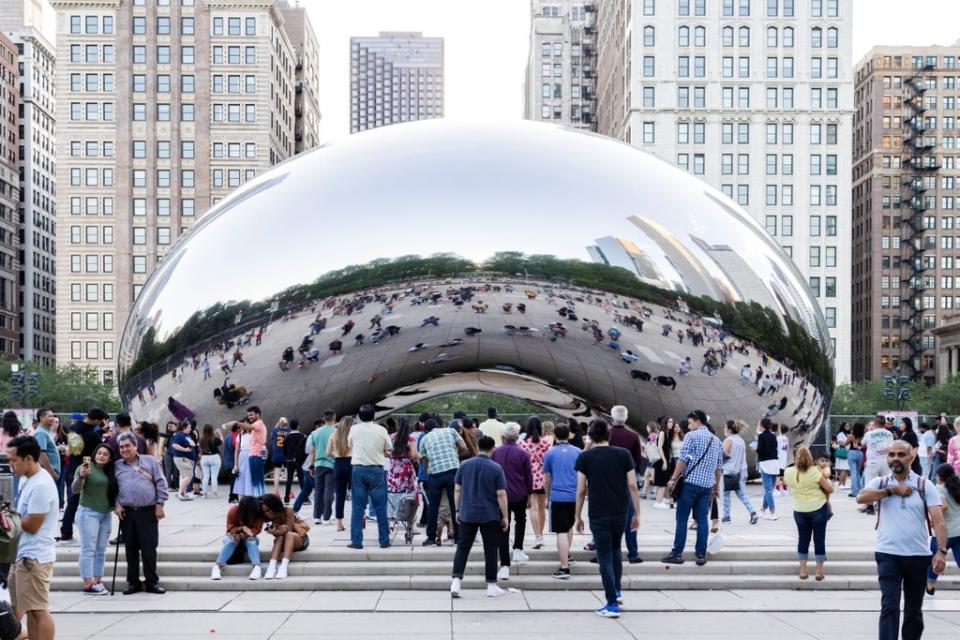Anish Kapoor: ‘The government is damn dangerous and a bunch of f***ing liars’

It’s a sign of the artist Anish Kapoor’s world-embracing fame that when British teenager Emma Raducanu was playing a tournament in Chicago, in the weeks before winning the US Open tennis championship, she found time to visit his Cloud Gate sculpture, the huge reflective “bean” that has become a tourist attraction as well as an acclaimed work of art.
“I love that,” he says, smiling broadly, throwing back his head to emphasise his words. “It was wonderful. It says something about how a work, or a body of work, can come to have a voice of its own. It’s nothing to do with me any more. It’s out there in the world and it’s doing its own thing. Of course, I love that.”
We are talking in a quiet white room at the Lisson Gallery in London, just as Kapoor is about to unveil an exhibition of his paintings. Made over the past year or so, they represent a new direction in his work, because although he has often used paint and pigment in his pieces – most memorably in the huge cannon that fired paint at the wall in his astonishing solo exhibition at the Royal Academy in 2009 – he is always described as a sculptor. A further and more extensive retrospective of his paintings opens at Modern Art Oxford on 2 October.
Ever since he first emerged as a major artist in the early 1990s – representing Britain at the Venice Biennale in 1990 and winning the Turner Prize in 1991 – Kapoor has attracted both artistic credibility and huge crowds. Popularity is something that has arrived without his entirely expecting it. “There’s no accounting for it,” he says. “You can’t either make it happen or not. It’s just there.”
I wonder whether he has deliberately courted success; whether he likes the sense of being feted. “I’ve had the opposite,” he says, after a long pause. “Which is, ‘Oh God, they like it so much there must be something wrong with it. It’s too popular. It’s too whatever.’”
He explains by talking about his reaction when Cloud Gate, made of highly reflective stainless steel, first went on show in the Millennium Park in 2006. “It was just on the cusp of the selfie, and it had thousands and thousands of people around it all the time. I thought, ‘What is this? Disneyland, here I come... It filled me with a kind of disappointment.
“But I went to Chicago and sat with it for three or four days to try to understand what was going on. Something occurred to me, which surprised me. It was a very simple thing, which was that this object has an indeterminate scale. When you’re near it, it’s enormous, but you don’t have to walk 10 metres away from it, and suddenly it becomes not so big. It has this mysterious jumping scale. Jumping scale is, I think, deeply poetic.”
Kapoor believes that this saved the piece – gave it serious intent. “There will be those who will get it and those who don’t,” he adds. “But I think holding on to these sometimes very ephemeral qualities is the real key to a work. We live in a world of objects, that are all known. We name them all. Only in art, and perhaps in the cosmos, are there a few that remain mysterious. And it seems to me that that’s a quality that might be intriguing and popular.”
This power of art to suggest something – a presence, or an absence – beyond itself, runs through all Kapoor’s work since the start, unifying his early works, in pigment and plaster, with his monumental public sculptures, his sky mirrors that reflect and distort the world around them, and now with the paintings. He completed them during lockdown, working in his studio at his Oxfordshire home and in his larger premises at a former factory in south London.

He has always painted – going so far, at one point, as to describe himself as a “painter working as a sculptor” – and sees the oils that now line the walls as part and parcel of his sculptural work. “I made pigment works years and years ago, which use colour that has both a material physical presence and an ethereal something else. That is what I am really interested in, this relationship between what is present and what isn’t.
“If one was to take a – forgive me for this, but I am going to jump in there – if one was to take a philosophical position on it, one might say that in the moment of living there’s a consciousness of some death, of some ephemeral beyond. Maybe it’s because I’m Indian, but maybe it’s because I’m interested in Heidegger, or maybe it’s all sorts of things, that this is constantly a point of reference – maybe more overtly in these paintings than before.”
This is how Kapoor talks, in his deep, highly educated voice, rolling his words around as if he’s about to give a lecture, constantly checking himself, daring himself to take the plunge to say something. He laughs a lot and speaks as if he is always smiling, even when he doesn’t agree with what you are saying.
Which he doesn’t when I suggest that maybe these rich, swirling oils, in reds and deep purples, tempered sometimes with shocks of lighter yellow and mauve, are products of the time of Covid, when everyone has been forced to face mortality every day. They look like landscapes, but also like the innards of bodies; of something pulled from beneath.
One is never fully independent of what’s happening in the world. It’s going to enter the scene somehow
Anish Kapoor
“I slightly resist the pandemic illustration,” he says, benign but firm. “I’m suspicious of quotidian commentary. I feel generally it doesn’t lead to good art. While I feel huge political, passionate anger, I don’t feel it is the job of art to act as agitprop in whatever way. Maybe the job of artists, but not of art. On the other hand, one is never fully independent of what’s happening in the world. It is there. It’s going to enter the scene somehow.”
What he does acknowledge is that, at 67, he thinks more about the passing of time. This consciousness is all the stronger because he has a three-year-old daughter, Habiba, with his second wife Sophie Walker, as well as two older children, Ishan and Alba, from his first marriage.
“I was always involved with my children,” he says – a claim backed up by a warm and loving phone call with Ishan that briefly interrupts our chat. “But this renewed involvement [with Habiba] is the most fabulous, delicious thing that could ever be. I’m also aware of turning into an old bugger. And if I’m sensitive to myself I have to be open to the notion that I have a young child, and god knows how much of her life I’ll see and all that stuff.
“It brings with it a sense of pathos. Have I changed?” He laughs. “Yes, inevitably. But I think at another level I might say I’m much less afraid. I think that’s one of the things that perhaps one can grow into as an artist: to say look, I don’t care any more what the art world or anybody thinks. I have to do what I have to do. And it will make of it what it does. It’s not for me to measure.”
It seems strange to think of Kapoor being afraid of anything or anyone; he exudes a confidence, a gleam of certainty. But he insists the doubts are there. “I think these are battles one has to fight with oneself,” he says. “Self-censorship is a real, real, real thing. And one has to open the way for oneself continually.”
The paintings in this sense represent a leap of faith. “My generation at art school were never taught to paint, or draw. It was never part of the scene. But I’ve had a journey over the past four or five years. I feel my inner voice, whatever that is, has made me accept the possibility of the image. What I’ve done in many ways is to resist it. We are supposedly free spirits, us artists. But not so. We are educated like everybody else into modes of practice. De-educating myself is the hardest job of all. To say, not only is it possible, but I have to dare to.”
He paints alone, in silence, without music: “It’s the only way.” When a work is completed, he looks at it, for a long time. “I’m a bloody workaholic and a half. So I work every single day. And I love making paintings. But making them is one part. The second part is to watch them, look at them – never show a work that’s less than six months old. I don’t believe in it. I’ve learnt over the years that you have to watch it, whether it’s a painting or a sculpture, to see whether it can hold authority.”

More or less at the same time as making these works, teaching himself the techniques of oil painting, he has been exploring pieces that use Vantablack, the blackest of black paints, which absorbs 99.9 per cent of all light and renders three-dimensional objects flat. “If painting technique brings the image into being with the use of paint, then this black stuff takes it away,” he says. “If you put it on a fold, you wouldn’t be able to see the fold. This thing of being and non-being is very important to me.”
His artistic experiments, because they are on a smaller scale than his more public-facing work, are likely to make him even more collectable, I suggest. He groans and covers his face. His relationship with the art market is a complex one; he despises the way that every piece of art is now “chained to the market… We artists have to fight this battle and it’s not a straightforward one,” he says. Has he ever thought about simply walking away?
“I’ve often thought about it,” he says, smiling wryly. “And maybe one day I’ll have the courage to do it. I love making things, and after years and years of psychoanalysis, [I know] that it is a conversation I have with myself that is vital to me. I’m not that interested in the object. I’m more interested in the conversation.
“It’s absolutely part of this strange place that culture finds itself in, at the moment, me included. It doesn’t matter what area of culture, other than perhaps poetry. The commercial, the capitalist world, has entered and we struggle to find an alternative.”
For this reason, he is full of admiration for the five collectives currently nominated for the Turner Prize for their work, which is by and large socially committed. “Bless them,” he says. “I hope they can find a way, or point a way at least. They speak of a different agenda. Their work is not about objects. I warn against agitprop, because art is, in the end – in its best and purest forms – unknowable. And yet we live in a time when right-wing social entrenchment is so enormous, encouraged by government, that I fully sympathise with artists who feel that social change is necessary.”
I am saddened by the xenophobia that Brexit has awakened
Anish Kapoor
His own campaigning finds outlets outside his art. He is outspoken on matters close to his heart. He loathes Brexit – “I am saddened by the xenophobia that it’s awakened” – and has no hesitation in calling the government “a bunch of f***ing liars”. I say I imagine him shouting at the television a lot during lockdown. He smiles again. “The sad truth is that if there was an election tomorrow, Boris Johnson would be elected. He declared fairly early on that he would be hard on culture and soft on the economy, and that’s what they’re doing. So, you know, bash the BBC, bash the universities, take hold of all the museums by putting their people on the boards. Is that not a form of neo-fascism? Isn’t it a way of taking control of the mind of the nation while feeding relatively liberal economic solutions to all sorts of things? Bloody clever, but damn dangerous, it seems to me.”
He has lived in England since the 1970s, when he moved here as a student. But what is going on in India, where he was born, terrifies him even more: the death toll caused by poverty and neglect; the rise of violent anti-Muslim sentiment encouraged by the Hindu nationalist government of Narendra Modi. “It’s gone absolutely insane,” he says. “I’ve been very vocal about my opposition to both the Hindu agenda and the BJP government. I describe them as the Hindu Taliban. That’s how they behave. It’s a return to a kind of medievalism that’s pointed at exclusion. That’s horrid.”
Kapoor is also sowing his own seeds of hope. Next year, at the Venice Biennale, he is mounting an exhibition at the Accademia, where his sculptural experiments with blackness will be shown for the first time. Simultaneously, he has agreed to renovate the crumbling Palazzo Manfrin, using it as a base for his foundation, a gallery for some of his works, and opening it up as a studio space for young artists. “It is madness!” he says, with a huge grin. “It’s quite a complicated restoration project, but I hope we can give it proper life. It felt the right thing to do. Jump in. See what happens!” Which seems to be his current motto for life.
Anish Kapoor: Painting is at Modern Art Oxford, 2 October - 13 February 2022. Tickets: modernartoxford.org.uk
Read More
Gene Simmons: ‘My eyesight’s good. My schmeckle works. What else do you want?’
What can the Sleeping Hermaphroditus teach us about love?
‘These are the traces of this tumult’: The precious artworks looted by the Nazis
Raducanu to have ‘a few days’ rest’ before returning to training
John McEnroe stands by controversial Emma Raducanu comments
How Raducanu can improve her game even further after US Open win

 Yahoo News
Yahoo News 